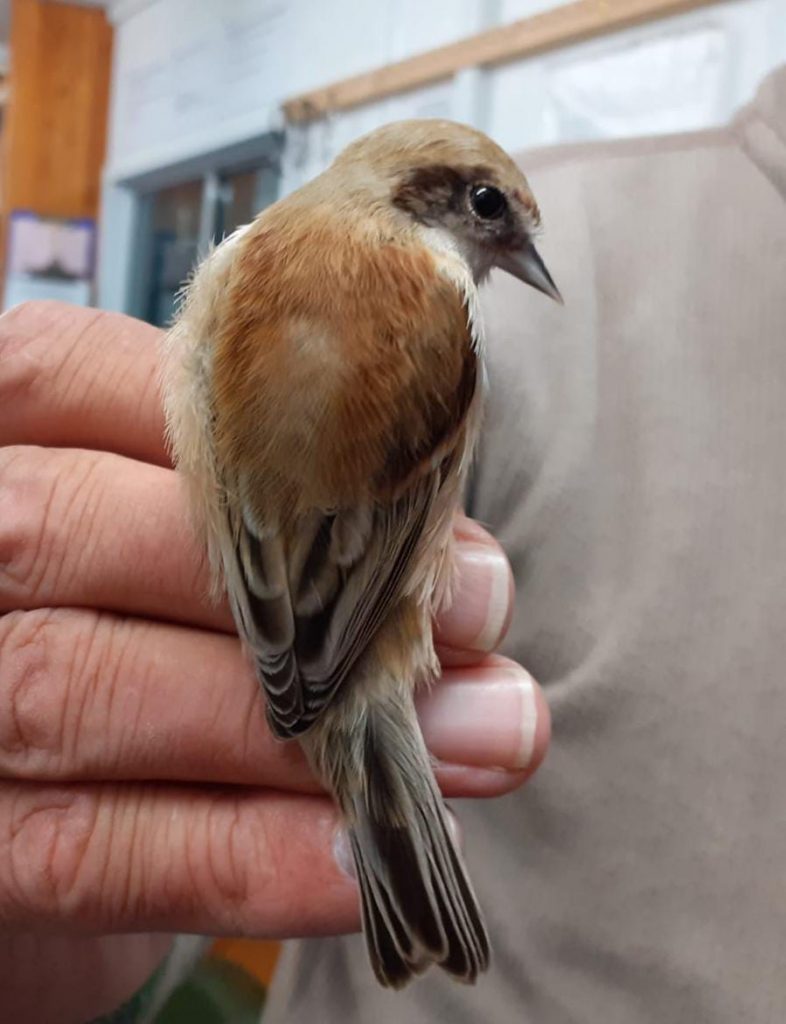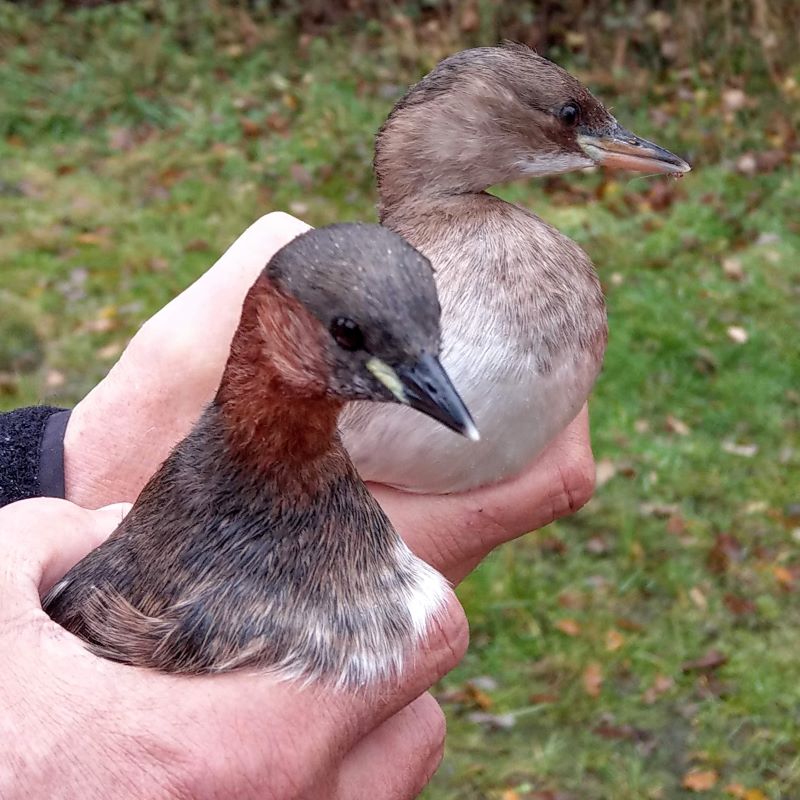Ringing and results
A review of ringing in 2023

In 2023 the group ringed a total of 2,712 new birds, which is a decrease of 245 birds from 2022 and just 66% of the long-term average (based on data from 1960 to date).
A total of 60 species were ringed, the same as last year, although these included two additions to the ringing list, which now stands at 143 species. These are all tabulated below.
With contributions from Roger Emmens, Alan Harris and Jan Swan
Once again this year, the efforts of the Group were hampered by various challenges.
Firstly, the resurgence of Avian Flu on the RSPB reserve in the spring brought about another ringing ban on their site from early April to the end of June. Unfortunately, this impacted ringing on our north CES site for the first half of the season, as well as the nestbox ringing we would ordinarily have conducted on that part of the site.
Secondly, there was the ongoing exclusion from the Thames Water Works area, to which was added our exclusion from the North Rough and Tealeaves as Thames Water conducted long term construction works to rebuild the main inbound pipeline to their site.
Thirdly, many summer visitors returned in lower than usual numbers with adverse weather in the Mediterranean during Spring migration a possible factor, and those that returned found our reedbeds in poor condition due to flattening by winter storms and snow. Added to this, cold weather in Spring affected many earlier breeding attempts.
Fourthly, far fewer Black-headed Gull pairs arrived to breed, perhaps due to last year’s predation events on the rafts. No site visits were possible due to bird flu restrictions, but shore-based surveys found much reduced numbers. Worse was to come: no chicks were fledged from the rafts, and we aren’t sure what happened, but predation at night seems again to have been the cause. There was some success for pairs breeding in the South Lagoons (including five pairs astonishingly nesting in trees on the lagoon banks) and on islands in the Scrape, but these weren’t generally accessible for chick ringing. In addition, only two Common Tern pairs attempted to nest and both failed.
But despite these setbacks there were some successes. Principal amongst these was the addition of two new species to the ringing list. Firstly, and more or less expected, was Greylag Goose, as these now breed locally and three goslings practically invited capture and ringing. Secondly, and far less expected, was a Penduline Tit that appeared one November evening as Alan Harris was preparing nets for a roost, and obliged by popping into one of them.
The group’s 6th Woodcock was caught during a winter thrush roost session; it was our first for 24 years. We also ringed our 10th and 11th Barn Owls, one of which was a full-grown bird caught during a morning Redwing netting session and our 14th Firecrest.
The use of thermal imaging units (and a lot of patience!) has, once again, paid off and contributed to our record Jack Snipe total of 45 birds (a very encouraging increase of 20 birds on last year). We are hopeful of starting to learn more about how these birds use the Rye Meads meadows during the winter.
Retraps, recoveries and controls

A highlight from the year was from a retrapped Little Grebe, showing remnants of summer plumage, caught on 9th December. After investigation, this bird turned out to have been ringed as a juvenile on 12th September 2015 by the late Toby Spall. A check of the BTO’s Online Ringing Report, which includes data to the end of 2022, we found that ‘our bird’ had surpassed the current longevity record of six years and 23 days by two years, two months, and five days. This seems a fitting tribute to the person who ringed it, having dedicated a good proportion of his spare time to ringing at Rye Meads.
Recoveries are birds ringed at Rye Meads which are then reported from elsewhere. Significant recoveries in 2023 included a Black-headed Gull for a second time, at the same site in Northern Ireland as the first time in December 2020. We also had our fifth Reed Warbler recovery in Belgium, as well as France and Dorset and a Sedge Warbler to France.
Controls are birds ringed elsewhere which we then find at Rye Meads. Pick of these in 2023 was a Shoveler which was originally ringed on 17th June 2011 in Germany. This was re-ringed by us as the original metal ring was very worn. We also added a colour ring as part of the Southern Colour Ringing Group’s project on Shoveler and Gadwall.
We had our first Great Black-backed Gull control, our first and second Mediterranean Gull controls, from Belgium and The Netherlands respectively, and our fourth Black-headed Gull from Finland, all thanks to reading colour rings in the field. Caught in a net was our second Chiffchaff from Denmark.
Full list of birds ringed
| Species | 1960-2021 | 2022 | 2023 | Grand Total | Comments |
|---|---|---|---|---|---|
| Canada Goose | 212 | 2 | 214 | ||
| Greylag Goose | 3 | 3 | Three goslings made this the 142nd species ringed at Rye Meads | ||
| Mute Swan | 315 | 7 | 5 | 327 | |
| Egyptian Goose | 13 | 13 | |||
| Shelduck | 41 | 41 | |||
| Garganey | 1 | 1 | |||
| Shoveler | 43 | 1 | 44 | ||
| Gadwall | 652 | 33 | 38 | 723 | Best total since 2010 thanks to the moulting flock |
| Mallard | 2,179 | 30 | 20 | 2,229 | |
| Pintail | 1 | 1 | |||
| Teal | 537 | 6 | 12 | 555 | |
| Pochard | 52 | 1 | 53 | ||
| Tufted Duck | 1,029 | 4 | 1 | 1,034 | |
| Ruddy Duck | 8 | 8 | |||
| Red-legged Partridge | 2 | 2 | |||
| Grey Partridge | 3 | 3 | |||
| Manx Shearwater | 1 | 1 | |||
| Little Grebe | 158 | 2 | 160 | The first birds for five years | |
| Great Crested Grebe | 17 | 17 | |||
| Bittern | 2 | 2 | |||
| Grey Heron | 18 | 1 | 19 | Our 19th bird, and most of the previous were ringed off site as chicks at the Netherhall heronry | |
| Little Egret | 1 | 1 | |||
| Gannet | 1 | 1 | |||
| Shag | 1 | 1 | |||
| Cormorant | 6 | 6 | |||
| Sparrowhawk | 101 | 2 | 103 | Only the third blank year of the past 40 | |
| Water Rail | 147 | 1 | 1 | 149 | |
| Moorhen | 2,089 | 3 | 8 | 2,100 | |
| Coot | 1,347 | 14 | 25 | 1,386 | |
| Lapwing | 117 | 117 | |||
| Ringed Plover | 16 | 16 | |||
| Little Ringed Plover | 212 | 212 | |||
| Bar-tailed Godwit | 1 | 1 | |||
| Ruff | 1 | 1 | |||
| Dunlin | 15 | 15 | |||
| Little Stint | 1 | 1 | |||
| Woodcock | 5 | 1 | 6 | ||
| Jack Snipe | 138 | 25 | 45 | 208 | A record year by some margin as we continue to improve the use of thermal imaging to find and capture these birds |
| Snipe | 303 | 303 | |||
| Common Sandpiper | 272 | 272 | |||
| Green Sandpiper | 90 | 90 | |||
| Solitary Sandpiper | 1 | 1 | |||
| Redshank | 24 | 24 | |||
| Wood Sandpiper | 2 | 2 | |||
| Greenshank | 3 | 3 | |||
| Black-headed Gull | 2,335 | 17 | 2 | 2,354 | A disastrous year as all pairs on the rafts failed |
| Common Gull | 1 | 1 | |||
| Herring Gull | 1 | 1 | |||
| Common Tern | 2,700 | 2,700 | Once again no pairs were successful on the rafts | ||
| Stock Dove | 188 | 6 | 5 | 199 | |
| Woodpigeon | 340 | 4 | 2 | 346 | |
| Turtle Dove | 78 | 78 | |||
| Collared Dove | 77 | 3 | 80 | ||
| Cuckoo | 103 | 3 | 3 | 109 | Equals last year as the best since 2001 |
| Barn Owl | 9 | 2 | 11 | Our tenth and eleventh birds ringed | |
| Tawny Owl | 25 | 7 | 2 | 34 | |
| Little Owl | 10 | 10 | |||
| Long-eared Owl | 4 | 4 | |||
| Short-eared Owl | 1 | 1 | |||
| Swift | 6,901 | 6,901 | |||
| Kingfisher | 1,429 | 17 | 14 | 1,460 | |
| Wryneck | 5 | 5 | |||
| Lesser Spotted Woodpecker | 28 | 28 | |||
| Great Spotted Woodpecker | 174 | 2 | 2 | 178 | |
| Green Woodpecker | 98 | 1 | 1 | 100 | |
| Kestrel | 125 | 3 | 128 | ||
| Hobby | 1 | 1 | |||
| Great Grey Shrike | 2 | 2 | |||
| Jay | 152 | 2 | 1 | 155 | |
| Magpie | 501 | 20 | 9 | 530 | |
| Jackdaw | 1 | 1 | |||
| Carrion Crow | 190 | 3 | 193 | ||
| Coal Tit | 31 | 31 | |||
| Marsh Tit | 9 | 9 | |||
| Willow Tit | 430 | 430 | |||
| Blue Tit | 12,123 | 249 | 191 | 12,563 | An underwhelming total in a poor year for our tits |
| Great Tit | 9,903 | 235 | 114 | 10,252 | Other than the Covid-hit year of 2020, our lowest total since 1989 |
| Penduline Tit | 1 | 1 | Our 143rd species ringed at Rye Meads | ||
| Bearded Tit | 162 | 2 | 164 | ||
| Skylark | 268 | 268 | |||
| Sand Martin | 7,383 | 5 | 35 | 7,423 | |
| Swallow | 6,669 | 58 | 91 | 6,818 | |
| House Martin | 7,877 | 7,877 | |||
| Cetti's Warbler | 551 | 73 | 59 | 683 | |
| Long-tailed Tit | 4,061 | 87 | 93 | 4,241 | |
| Wood Warbler | 2 | 2 | |||
| Willow Warbler | 8,775 | 41 | 9 | 8,825 | Second lowest total for 62 years as they continue to decline in southern Britain |
| Chiffchaff | 9,576 | 366 | 239 | 10,181 | |
| Sedge Warbler | 24,820 | 212 | 301 | 25,333 | Sedge and Reed Warblers were the only warblers whose numbers have increased despite lower breeding numbers |
| Reed Warbler | 18,762 | 346 | 499 | 19,607 | Once again our most ringed bird of the year |
| Grasshopper Warbler | 115 | 2 | 117 | ||
| Savi's Warbler | 1 | 1 | |||
| Blackcap | 12,795 | 359 | 228 | 13,382 | |
| Garden Warbler | 3,523 | 65 | 62 | 3,650 | |
| Barred Warbler | 2 | 2 | |||
| Lesser Whitethroat | 2,852 | 13 | 9 | 2,874 | |
| Whitethroat | 5,327 | 79 | 59 | 5,465 | |
| Firecrest | 13 | 1 | 14 | Our 14th Firecrest and the first since 2017 | |
| Goldcrest | 977 | 18 | 19 | 1,014 | |
| Wren | 6,958 | 124 | 93 | 7,175 | |
| Nuthatch | 13 | 13 | |||
| Treecreeper | 420 | 14 | 9 | 443 | |
| Starling | 3,275 | 4 | 60 | 3,339 | Best total since 1985 thanks to a reedbed roost |
| Ring Ouzel | 1 | 1 | |||
| Blackbird | 7,992 | 54 | 38 | 8,084 | |
| Fieldfare | 579 | 1 | 580 | ||
| Redwing | 1,118 | 23 | 24 | 1,165 | |
| Song Thrush | 4,713 | 29 | 16 | 4,758 | |
| Mistle Thrush | 20 | 20 | |||
| Spotted Flycatcher | 108 | 108 | |||
| Robin | 4,064 | 106 | 54 | 4,224 | |
| Bluethroat | 1 | 1 | |||
| Nightingale | 14 | 14 | |||
| Pied Flycatcher | 7 | 7 | |||
| Black Redstart | 4 | 4 | |||
| Redstart | 14 | 14 | |||
| Whinchat | 59 | 59 | |||
| Stonechat | 74 | 1 | 75 | ||
| Wheatear | 41 | 41 | |||
| Dipper | 1 | 1 | |||
| House Sparrow | 3,873 | 3,873 | |||
| Tree Sparrow | 4,958 | 4,958 | |||
| Dunnock | 7,902 | 76 | 59 | 8,037 | |
| Yellow Wagtail | 1,548 | 1,548 | |||
| Grey Wagtail | 377 | 2 | 1 | 380 | |
| Pied Wagtail | 4,084 | 4,084 | |||
| Meadow Pipit | 1,432 | 22 | 35 | 1,489 | Best since 2017 |
| Tree Pipit | 4 | 4 | |||
| Water Pipit | 42 | 42 | |||
| Rock Pipit | 4 | 4 | |||
| Chaffinch | 3,598 | 1 | 3,599 | The first blank year since 1960! | |
| Brambling | 163 | 163 | |||
| Hawfinch | 2 | 2 | |||
| Bullfinch | 3,259 | 2 | 3 | 3,264 | |
| Greenfinch | 11,227 | 18 | 18 | 11,263 | |
| Linnet | 5,626 | 1 | 1 | 5,628 | |
| Lesser Redpoll | 855 | 3 | 858 | ||
| Goldfinch | 3,494 | 5 | 13 | 3,512 | |
| Siskin | 83 | 83 | |||
| Corn Bunting | 231 | 231 | |||
| Yellowhammer | 1,691 | 15 | 1 | 1,707 | |
| Little Bunting | 1 | 1 | |||
| Reed Bunting | 9,529 | 35 | 66 | 9,630 | Best for five years thanks to a roost |
| Total ringed | 256,123 | 2,957 | 2,712 | 261,792 | Just 66% of our long term average annual total, reflecting the loss of important sites at Tealeaves and the Works |
| Number of species | 141 | 60 | 60 | 143 |
